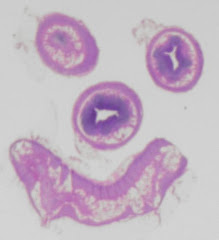Those of you who follow this blog from time to time and who are not PA Section (of the CAP) members should be made aware of an important development regarding the newly-revised MIS Standards (previously known as the MIS Guidelines). The Canadian Institute for Health Information (CIHI) has taken over two years to put into place a sweeping change in the Standards which affect all laboratories (ie. labs that use the Workload Measurement System, WMS, to monitor workload). Among the many changes is the incorporation of a number of changes that directly affect PAs. The previous version of the Standards had NO units which directly recognized the existence of PAs. The new version recognizes the tasks that PAs perform in both autopsy and surgical pathology. In keeping with the provincial Fee Guides (for pathologists), they allow PAs to claim units for the different complexities of surgical specimens. PAs may now claim units for consulting with a pathologist prior to grossing a specimen, for photography, for sampling for ancillary studies (EM, tumour banking, etc.) and for various other duties in the gross room. In the morgue, PAs may now claim units which truly reflect their efforts when performing routine, as well as specific dissections, for preparing a clinical history, for reporting on the case, etc. What used to be, quite frankly, both frustrating and embarrassing, has changed over night.
This ought to be pretty momentous news for PAs, whether their institution uses the units or not. PAs should realize that this is (finally!) a recognition and a validation of not only their profession but of the many tasks that they perform. Many hospitals use the WMS to justify resources from the Ministry from year to year. PAs have heretofore, compared to the Technologists beside whom they have been working for over 30 years, not appeared to be contributing. In fact, Lab Technicians, Lab Assistants, Morgue Attendants and others appeared to contribute more to the annual workload than did PAs. Now, there will be quite a large jump in the units and as a result, PAs can hold their heads high in the knowledge that they are pulling their weight.
The productivity of PAs may now be compared between sites, between hospitals, between provinces and -- important to supervisors and managers -- between individuals. To this end, it is important to lobby the necessary individuals in your organization to update the WMS in your particular IT system with the new Standards. Be aware that there are still some outstanding tasks which are on the list but which have yet to be determined (eg. the number of units to be assigned to a particular task).
It is somewhat fortunate that the complexity of surgical pathology specimens closely (but not exactly) mirrors that which is used by the pathologists. As a result, just one complexity needs to be entered into the IT system for each specimen and this can be used to monitor the workload of both the PA and the pathologist. There may be some debate as to the method for entering the complexity (ie. who enters the code that defines the complexity? The person performing the accessioning of the case? The PA? The pathologist?) but any system is better than none at all. A perceived shortcoming may be that the system does not abide by the widely accepted L4E (level 4 equivalent) system for monitoring the workload of pathologists. The WMS for PAs was, in keeping with the prescribed method of the CIHI, created based on the amount of time that is required to complete a given task, not on the basis of the relative 'importance' of a task. Thus, there will be some minor (justified) differences which some may notice when comparing the two systems. For example, it takes quite a bit of time for a PA to process a leg amputation but the relative importance of that specimen is very low.
Sunday, February 15, 2009
Subscribe to:
Post Comments (Atom)



No comments:
Post a Comment